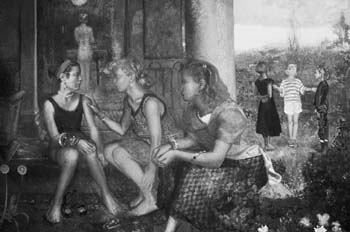![[MetroActive Arts]](/gifs/art468.gif)
[ Arts Index | Santa Cruz | MetroActive Central | Archives ]
Myth, Magic, Multiverse
Magic realist painter Frank Galuszka gives visual mythology a run for its money
By Christina Waters
CHRISTIAN MARTYRS, Hindu gods and the Mojave desert all form part of the painted mythology Frank Galuszka has articulated over 25 years. Galuszka, a professor of art at UC-Santa Cruz, came to California five years ago after several decades as a prominent force in Philadelphia's figurative painting movement. His canvases have found their way into museums and private collections all over the United States, Europe and the Middle East.
Trained in Rome and on the East Coast, Galuszka belongs to an increasingly rare company of oil painters schooled in Renaissance master techniques. That is, he can apply the techniques when he wants to. Just as often his images fracture as if by random particle acceleration. In the retrospective show of works Galuszka presents Thursday, viewers can feast on an evolution--and disintegration--of imagery evoking both Caravaggio and Bonnard.
A juggler of the celestial and the mundane, of excess and sacrifice, Galuszka has reinvented his personal style more than once over the years, moving confidently from mythic realism to explosive abstraction--and back again. Each painting holographically echoes fragments of the others. What unfolds is an opulent hall of mirrors reflecting far-flung corners of an imaginary universe--a universe created by those very mirrors. Mythic motifs appear and disappear as if down some Alice-in-Wonderland rabbit hole, turning up again--slightly altered, slightly deconstructed--somewhere else.
Galuszka colonizes his paintings with a voluptuous iconography, catalyzed by a multiyear study, La Vista Totale: A Partial View. Influenced by the cybernetic concept of the feedback loop, this series incorporates the viewer's point of view within its very structure, shifting disturbingly from microscopic detail to interstellar vastness. The picture plane often appears to shift in and out of focus, with sudden eruptions of discontinuous times and spaces within a single image.
In these monumental works, two mysterious figures conduct secret negotiations in the middle of an enchanted landscape. Through dozens of works these two women--metaphors for the forces of darkness and light, innocence and experience--meet in various guises. Each succeeding painting mirrors past ones so that Galuszka's arsenal of icons appears to mutate like cells unraveling in the most beautiful way possible.
In other paintings, Galuszka dissects the secret life of the mundane. A woman slumps over her housework while dishes, glassware and the kitchen sink turn to diamonds around her. The fetid trash of archetypal ghettos haunts a terrace where it is always sunset, and a trio of women glower toward a future that never arrives. Worn floors morph into prisms, and flowers as poignant as anything by Leonardo struggle to bloom amid decay. All this striking personal mythology explores the changes and ruptures of Galuszka's own odyssey with breathtaking candor.
Paintings from the late '80s form elaborate analogues for sci-fi guru Philip K Dick's V.A.L.I.S./Zebra complex and for Chilean Humberto Maturana's "coordination of coordinations of actions." Subsequently, by applying Maturana's ideas about the philosophy of biology to painting, Galuszka orchestrated a chorus of styles in La Vista Totale filled with the idyllic chaos of intersecting universes. Here the ancient and modern--Eden and Hades--have their molecules rearranged in the artist's transporter beam. Often the very cellular structure of Galuszka's forests, porticos, deserts and dieties threatens to disintegrate into a shimmering cosmic dust.
In the mid '90s, the subject of Galuszka's paintings began to shape-shift once again, influenced by travels to the Mojave. He streamlined his palette--with radiant effect. True to the holographic concept that all worlds are present in each--all times intersect in the now--Galuszka now finds Joan of Arc triumphant in Death Valley, Venus washed ashore near Davenport and a coyote keeping watch over an Old Testament kitchen.
Frank Galuszka's talk, "Painting, Myth and Multiversa," is sure to dazzle. It is one thing to see such a range of arresting artworks. And it is quite another to hear the artist's own confessions about style, motivation and dreams.
[ Santa Cruz | MetroActive Central | Archives ]
Copyright © Metro Publishing Inc. Maintained by Boulevards New Media.
![]()

Mythic Master: Painter Frank Galuszka constructs images of the celestial and the mundane, of excess and sacrifice, with the techniques of Renaissance masters--that is, if he chooses to.
Frank Galuszka presents his art lecture, "Painting, Myth and Multiversa," at 7pm on Thursday (Dec. 9) at the Museum of Art and History, 705 Front St, Santa Cruz. Free. (429.1964)
From the December 8-15, 1999 issue of Metro Santa Cruz.